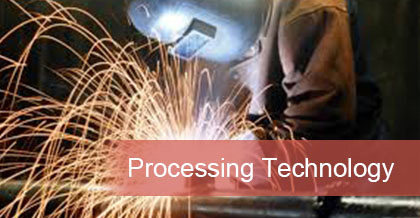API 5L Grade B Line Pipe Specification Introduction
API 5L Grade B is a steel grade of carbon steel pipe standard widely used in oil and gas pipeline systems. As part of the API 5L specification developed by the American Petroleum Institute (API), Grade B pipe is suitable for transporting natural gas, petroleum products and water, and has 2 specification levels: PSL1 and PSL2. PSL2 has more stringent requirements in chemical composition control, mechanical property testing, non-destructive testing and quality traceability.
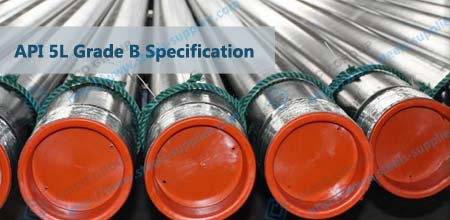
- Standard: API 5L (version number must be specified, such as 46th edition or latest edition)
- Grade: B
- Product Specification Level: PSL1 (basic requirements) / PSL2 (additional more stringent requirements)
- Manufacturing process: seamless (SMLS), electric resistance welding (ERW), straight seam submerged arc welding (LSAW), spiral submerged arc welding (SSAW)
- Main applications: Onshore and offshore oil and gas pipelines. (Remove "structural pipes, mechanical use", API 5L is a pipeline, not a structural standard)
AGICO is one of the most comprehensive supplier of piping system materials like API 5L Grade B Pipe, focusing on supplying line pipe products for piping system projects of Oil & Gas transportation, Refinery & Chemical, Marine & Offshore, Platform, Nuclear & Wind Power markets.
Common Types of API 5L Grade B Line Pipe:
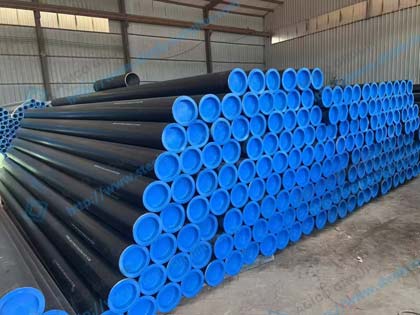 Seamless Pipe
Seamless Pipe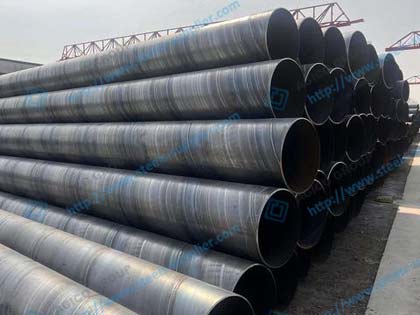 SSAW Pipe
SSAW Pipe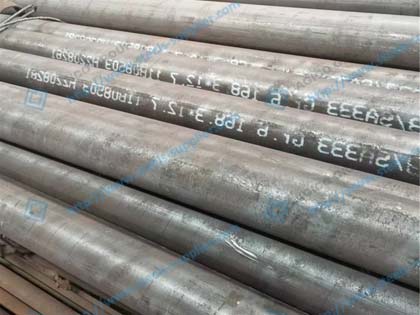 LSAW and ERW Pipe
LSAW and ERW PipeAPI 5L Grade B line pipes are supplied in both seamless and welded types to meet different project requirements.
- Seamless pipes are often the first choice for high-pressure, critical operations and smaller diameters due to their integrity.
- Welded pipes (ERW, LSAW, SSAW) are widely used for larger diameter pipelines and have cost-effective advantages.
API 5L Grade B Chemical Compostion:
| PSL 1 Steel Grade | Mass fraction, % based on heat and product analyses a,g | ||||||
|---|---|---|---|---|---|---|---|
| C | Mn | P | S | V | Nb | Ti | |
| max b | max b | max | max | max | max | max | |
|
|
|||||||
| B | 0.28 | 1.2 | 0.3 | 0.3 | c,d | c,d | d |
|
|
|||||||
| B | 0.26 | 1.2 | 0.3 | 0.3 | c,d | c,d | d |
|
a. Cu ≤ = 0.50% Ni; ≤ 0.50%; Cr ≤ 0.50%; and Mo ≤ 0.15%, b. For each reduction of 0.01% below the specified maximum concentration for carbon, an increase of 0.05% above the specified maximum concentration for Mn is permissible, up to a maximum of 1.65% for grades ≥ L245 or B, but ≤ L360 or X52; up to a maximum of 1.75% for grades > L360 or X52, but < L485 or X70; and up to a maximum of 2.00% for grade L485 or X70., c. Unless otherwise agreed NB + V ≤ 0.06%, d. Nb + V + TI ≤ 0.15%, e. Unless otherwise agreed., f. Unless otherwise agreed, NB + V = Ti ≤ 0.15%, g. No deliberate addition of B is permitted and the residual B ≤ 0.001% |
|||||||
| PSL2 Steel Grade | Mass fraction, % based on heat and product analyses | Carbon Equiv a | |||||||||||||||||||
|---|---|---|---|---|---|---|---|---|---|---|---|---|---|---|---|---|---|---|---|---|---|
| C | Si | Mn | P | S | V | Nb | Ti | Other | CE IIW | CE Pcm | |||||||||||
| max b | max | max b | max | max | max | max | max | max | max | ||||||||||||
|
|
|||||||||||||||||||||
| BR | 0.24 | 0.4 | 1.2 | 0.025 | 0.015 | c | c | 0.04 | e,l | 0.43 | 0.25 | ||||||||||
| BN | 0.24 | 0.4 | 1.2 | 0.025 | 0.015 | c | c | 0.04 | e,l | 0.43 | 0.25 | ||||||||||
| BQ | 0.18 | 0.45 | 1.4 | 0.025 | 0.015 | 0.05 | 0.05 | 0.04 | e,l | 0.43 | 0.25 | ||||||||||
|
|
|||||||||||||||||||||
| BM | 0.22 | 0.45 | 1.2 | 0.025 | 0.015 | 0.05 | 0.05 | 0.04 | e,l | 0.43 | 0.25 | ||||||||||
|
a. SMLS t>0.787”, CE limits shall be as agreed. The CEIIW limits applied fi C > 0.12% and the CEPcm limits apply if C ≤ 0.12%, b. For each reduction of 0.01% below the specified maximum for C, an increase of 0.05% above the specified maximum for Mn is permissible, up to a maximum of 1.65% for grades ≥ L245 or B, but ≤ L360 or X52; up to a maximum of 1.75% for grades > L360 or X52, but < L485 or X70; up to a maximum of 2.00% for grades ≥ L485 or X70, but ≤ L555 or X80; and up to a maximum of 2.20% for grades > L555 or X80., c. Unless otherwise agreed Nb = V ≤ 0.06%, d. Nb = V = Ti ≤ 0.15%, e. Unless otherwise agreed, Cu ≤ 0.50%; Ni ≤ 0.30% Cr ≤ 0.30% and Mo ≤ 0.15%, f. Unless otherwise agreed, g. Unless otherwise agreed, Nb + V + Ti ≤ 0.15%, h. Unless otherwise agreed, Cu ≤ 0.50% Ni ≤ 0.50% Cr ≤ 0.50% and MO ≤ 0.50%, i. Unless otherwise agreed, Cu ≤ 0.50% Ni ≤ 1.00% Cr ≤ 0.50% and MO ≤ 0.50%, j. B ≤ 0.004%, k. Unless otherwise agreed, Cu ≤ 0.50% Ni ≤ 1.00% Cr ≤ 0.55% and MO ≤ 0.80%, l. For all PSL 2 pipe grades except those grades with footnotes j noted, the following applies. Unless otherwise agreed no intentional addition of B is permitted and residual B ≤ 0.001%. |
|||||||||||||||||||||
Note: PSL2 has stricter control requirements on harmful elements (P and S) and may contain micro-alloying elements (Nb, V, Ti) to meet higher mechanical properties and toughness requirements. Both PSL1 and PSL2 need to meet carbon equivalent (CE) requirements to ensure weldability.
API 5L Grade B Mechanical Property:
| Pipe Grade | Tensile Properties – Pipe Body of SMLS and Welded Pipes PSL 1 | Seam of Welded Pipe | ||
|---|---|---|---|---|
| Yield Strength a | Tensile Strength a | Elongation | Tensile Strength b | |
| Rt0,5 PSI Min | Rm PSI Min | (in 2in Af % min) | Rm PSI Min | |
| B | 35,500 | 60,200 | c | 60,200 |
| a. For intermediate grade, the difference between the specified minimum tensile strength and the specified minimum yield for the pipe body shall be as given for the next higher grade. | ||||
| b. For the intermediate grades, the specified minimum tensile strength for the weld seam shall be the same as determined for the body using foot note a. | ||||
| c. The specified minimum elongation, Af, expressed in percent and rounded to the nearest percent, shall be determined using the following equation: | ||||
| Where C is 1 940 for calculation using Si units and 625 000 for calculation using USC units | ||||
| Axc is the applicable tensile test piece cross-sectional area, expressed in square millimeters (square inches) , as follows | ||||
| – For circular cross-section test pieces, 130mm2 (0.20 in2) for 12.7 mm (0.500 in) and 8.9 mm (.350 in) diameter test pieces; and 65 mm2 (0.10 in2) for 6.4 mm (0.250in) diameter test pieces. | ||||
| – For full-section test pieces, the lesser of a) 485 mm2 (0.75 in2) and b) the cross-sectional area of the test piece, derived using the specified outside diameter and the specified wall thickness of the pipe, rounded to the nearest 10 mm2 (0.10in2) | ||||
| – For strip test pieces, the lesser of a) 485 mm2 (0.75 in2) and b) the cross-sectional area of the test piece, derived using the specified width of the test piece and the specified wall thickness of the pipe, rounded to the nearest 10 mm2 (0.10in2) | ||||
| U is the specified minimum tensile strength, expressed in megapascals (pounds per square inch) | ||||
| Pipe Grade | Tensile Properties – Pipe Body of SMLS and Welded Pipes PSL 2 | Seam of Welded Pipe | |||||
|---|---|---|---|---|---|---|---|
| Yield Strength a | Tensile Strength a | Ratio a,c | Elongation | Tensile Strength d | |||
| Rt0,5 PSI Min | Rm PSI Min | R10,5IRm | (in 2in)Af % | Rm (psi) | |||
| Minimum | |||||||
| Minimum | Maximum | Minimum | Maximum | Maximum | Minimum | ||
| BR, BN,BQ,BM | 35,500 | 65,300 | 60,200 | 95,000 | 0.93 | f | 60,200 |
| a. For intermediate grade, refer to the full API5L specification. | |||||||
| b. for grades > X90 refer to the full API5L specification. | |||||||
| c. This limit applies for pies with D> 12.750 in | |||||||
| d. For intermediate grades, the specified minimum tensile strength for the weld seam shall be the same value as was determined for the pipe body using foot a. | |||||||
| e. for pipe requiring longitudinal testing, the maximum yield strength shall be ≤ 71,800 psi | |||||||
| f. The specified minimum elongation, Af, expressed in percent and rounded to the nearest percent, shall be determined using the following equation: | |||||||
| Where C is 1 940 for calculation using Si units and 625 000 for calculation using USC units | |||||||
| Axc is the applicable tensile test piece cross-sectional area, expressed in square millimeters (square inches) , as follows | |||||||
| – For circular cross-section test pieces, 130mm2 (0.20 in2) for 12.7 mm (0.500 in) and 8.9 mm (.350 in) diameter test pieces; and 65 mm2 (0.10 in2) for 6.4 mm (0.250in) diameter test pieces. | |||||||
| – For full-section test pieces, the lesser of a) 485 mm2 (0.75 in2) and b) the cross-sectional area of the test piece, derived using the specified outside diameter and the specified wall thickness of the pipe, rounded to the nearest 10 mm2 (0.10in2) | |||||||
| – For strip test pieces, the lesser of a) 485 mm2 (0.75 in2) and b) the cross-sectional area of the test piece, derived using the specified width of the test piece and the specified wall thickness of the pipe, rounded to the nearest 10 mm2 (0.10in2) | |||||||
| U is the specified minimum tensile strength, expressed in megapascals (pounds per square inch | |||||||
| g. Lower values fo R10,5IRm may be specified by agreement | |||||||
| h. for grades > x90 refer to the full API5L specification. | |||||||
Note: PSL2 pipe grade requires impact testing to ensure notch toughness, which is particularly important in low temperatures, offshore environments, high pressure or sour service conditions (where applicable).
Tolerances of Outside Diameter, Out of roundness and Wall thickness
| Specified Outside Diameter D (in) | Diameter Tolerance, inches d | Out-of-Roundness Tolerance in | ||||
|---|---|---|---|---|---|---|
| Pipe except the end a | Pipe end a,b,c | Pipe except the End a | Pipe End a,b,c | |||
| SMLS Pipe | Welded Pipe | SMLS Pipe | Welded Pipe | |||
| < 2.375 | -0.031 to + 0.016 | – 0.031 to + 0.016 | 0.048 | 0.036 | ||
| ≥2.375 to 6.625 | 0.020D for | 0.015D for | ||||
| +/- 0.0075D | – 0.016 to + 0.063 | D/t≤75 | D/t≤75 | |||
| By agreement for | By agreement for | |||||
| D/t≤75 | D/t≤75 | |||||
| >6.625 to 24.000 | +/- 0.0075D | +/- 0.0075D, but max of 0.125 | +/- 0.005D, but max of 0.063 | 0.020D | 0.015D | |
| >24 to 56 | +/- 0.01D | +/- 0.005D but max of 0.160 | +/- 0.079 | +/- 0.063 | 0.015D for but max of 0.060 For D/t≤75 By agreement for D/t≤75 | 0.01D for but max of 0.500 For D/t≤75 By agreement for D/t≤75 |
| >56 | As agreed | |||||
| a. The pipe end includes a length of 4 in ate each of the pipe extremities | ||||||
| b. For SMLS pipe the tolerance apply for t≤0.984in and the tolerances for the thicker pipe shall be as agreed | ||||||
| c. For expanded pipe with D≥8.625in and for non-expanded pipe, the diameter tolerance and the out-of-roundness tolerance may be determined using the calculated inside diameter or measured inside diameter rather than the specified OD. | ||||||
| d. For determining compliance to diameter tolerance, the pipe diameter is defined as the circumference of the pipe in any circumferential plane divide by Pi. | ||||||
| Wall thickness | Tolerances a |
|---|---|
| t inches | inches |
| SMLS pipe b | |
| ≤ 0.157 | -1.2 |
| > 0.157 to < 0.948 | + 0.150t / – 0.125t |
| ≥ 0.984 | + 0.146 or + 0.1t, whichever is the greater |
| – 0.120 or – 0.1t, whichever is the greater | |
| Welded pipe c,d | |
| ≤ 0.197 | +/- 0.020 |
| > 0.197 to < 0.591 | +/- 0.1t |
| ≥ 0.591 | +/- 0.060 |
| a. If the purchase order specifies a minus tolerance for wall thickness smaller than the applicable value given in this table, the plus tolerance for wall thickness shall be increased by an amount sufficient to maintain the applicable tolerance range. | |
| b. For pipe with D≥ 14.000 in and t≥0.984in, the wall thickness tolerance locally may exceed the plus tolerance for wall thickness by an additional 0.05t provided that the plus tolerance for mass is not exceeded. | |
| c. The plus tolerance for wall thickens does not apply to the weld area | |
| d. See the full API5L spec for full details | |
API 5L Grade B Pipe Quality Assurance
Fabrication and Welding Properties
| Fabrication | Description |
|---|---|
| Solderability | Good; relatively low carbon content and controlled carbon equivalent facilitates welding. |
| Preheat | Normally only required for thicker sections, specific steel grades, cold environments or when required by a qualified welding procedure specification (WPS). |
| Heat Treatment | PSL2 pipes may be normalized or quenched and tempered to meet additional toughness requirements. PSL1 is usually delivered in the as-rolled condition. |
| Cold bending | Cold bending is allowed, but appropriate tools must be used and the minimum bending radius must be set to meet the requirements of the specifications to avoid excessive deformation or damage to material properties. |
| Welding requirements | A qualified welding procedure specification (WPS) and procedure qualification record (PQR) based on the specification must be followed. For PSL2 pipelines, the traceability and mechanical integrity requirements are extremely strict , and the welding procedure qualification and welder qualification requirements are also higher. |
Testing Requirements
API 5L PSL1 Grade B Line Pipe
- Hydrostatic test (each pipe)
- Non-destructive testing (NDT): 100% weld ultrasonic or radiographic testing (small diameter ERW pipes allow sampling according to specifications)
- Visual inspection (inside and outside surfaces of each tube)
API 5L PSL2 Grade B Line Pipe
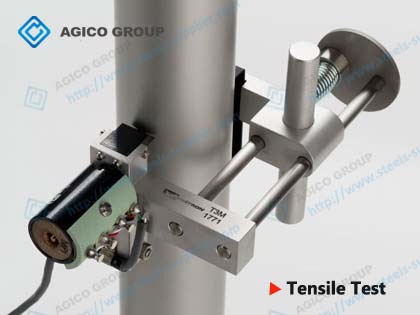
- Hydrostatic test (each pipe)
- Non-destructive testing (NDT): 100% full weld ultrasonic or radiographic testing (usually requires both methods or the more sensitive method)
- Charpy V-Notch (CVN) impact test (per batch, specified temperature and absorbed energy)
- Hardness test (if required, such as acid service conditions)
- Dimension and tolerance checks (more stringent)
- Weight Check
Marking and Certification
Pipeline markings must comply with API 5L standards, be legible and durable, and include:
- Manufacturer's name or trademark
- Pipeline class and specification (e.g., API 5L B PSL2 )
- Dimensions (outer diameter, wall thickness), weight grade/wall thickness code, weight per unit length
- Manufacturing process (such as SMLS, ERW, LSAW, SSAW)
- Furnace number, batch number
- Tube number (usually required for PSL2)
- PSL2 Supplementary Requirements Marking (if applicable) (Additional key points)
- API Monogram (if the manufacturer holds an API Monogram license)
Testing and Certification:
- PSL1: Factory test certificate (EN 10204 Type 3.1)
- PSL2: Factory test certificate (EN 10204 Type 3.1 or more commonly Type 3.2) (Clearly define the differences in certification levels)
Common Applications of API 5L Grade B Pipe
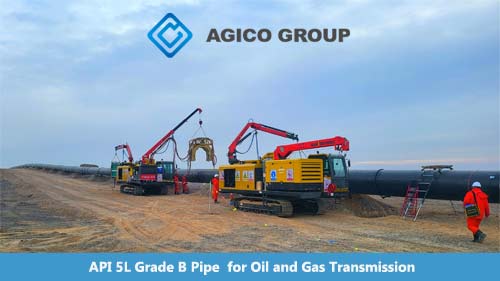
- Oil and gas transportation: long-distance and gathering pipelines for crude oil, natural gas, refined oil and water onshore and offshore.
- Pipeline related: pipelines within the pipeline system, valve room connecting pipes, etc.
-
(Secondary Applications): In some non-regulatory or less demanding scenarios, it is sometimes used for:
- Piled foundations (note differences in standards and additional certification that may be required)
- Casing/conduit (must comply with the additional requirements for pipe ends in API 5L or refer to API 5CT)
- Large structural supports (not a major design criterion)
- Water supply and sewage transportation (water quality compatibility needs to be considered)
- Mechanical structural parts (not pressure vessel body).
API 5L Grade B Line Pipe Products Supply from AGICO
A full range of API 5L Grade B Line Pipe products is available in seamless and welded types, with the exact size range available depending on the manufacturer's capabilities and the process selected.
Manufacturing Method of API 5L Grade B Pipe
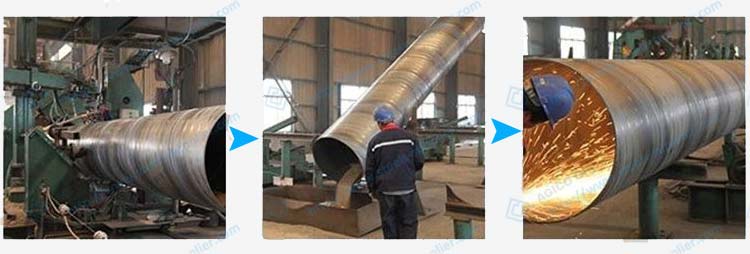
- Seamless tubes (SMLS) – produced by hot rolling or cold drawing. Suitable for high pressure, critical applications and small to medium diameters.
- ERW (electric resistance welding) – commonly used for small and medium diameter pipes. Modern high frequency welding (HFW/ERW) has significantly improved quality and can be used for important pipelines.
- LSAW (Longitudinal Submerged Arc Welding) – Suitable for large diameter, thick wall pipes. Usually uses UOE or JCOE forming process.
- SSAW (Spiral Submerged Arc Welding) – Suitable for large diameter pipes. Can be used for long distance transmission pipelines of various pressure levels. (Removing the “low pressure” limitation, SSAW can also be used for high pressure)
Size Range of API 5L Grade B Line Pipe
| Parameter | Range |
|---|---|
| Outer diameter (OD) | 10.3 mm (NPS ⅜ ) – 1420 mm+ |
| Wall thickness (WT) | SCH 10 – SCH 160, XXS, etc. |
| length | Single or double length, random length or custom cut length |


